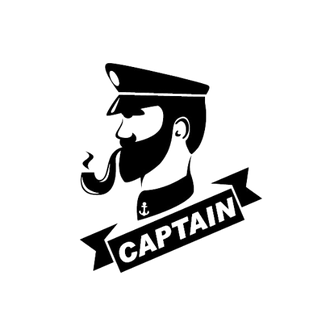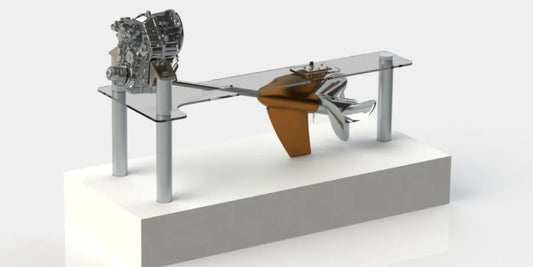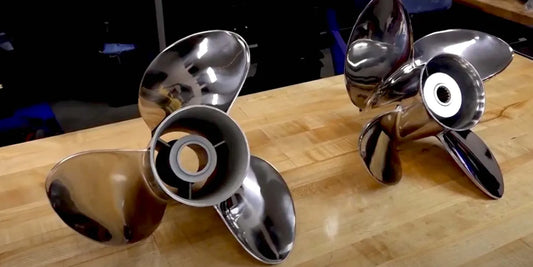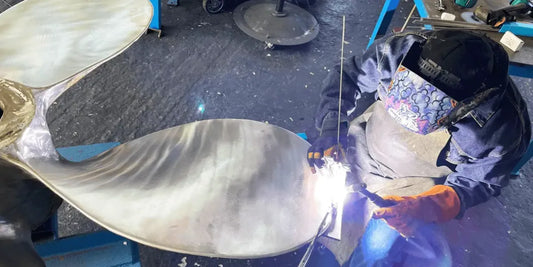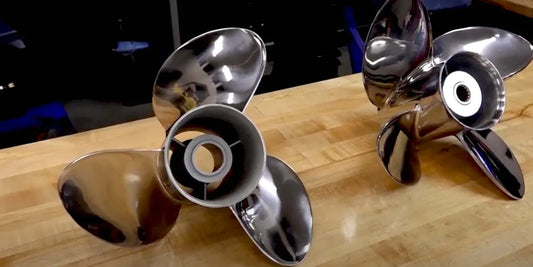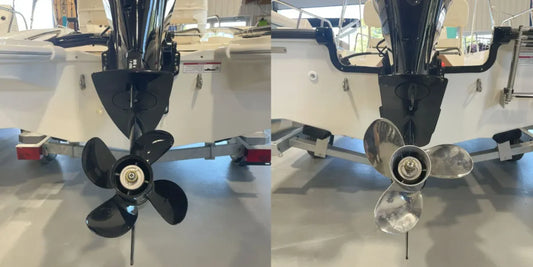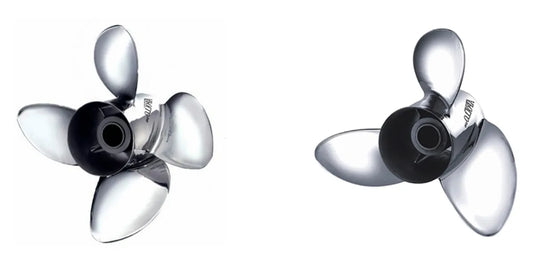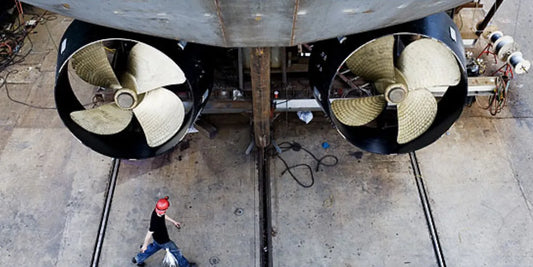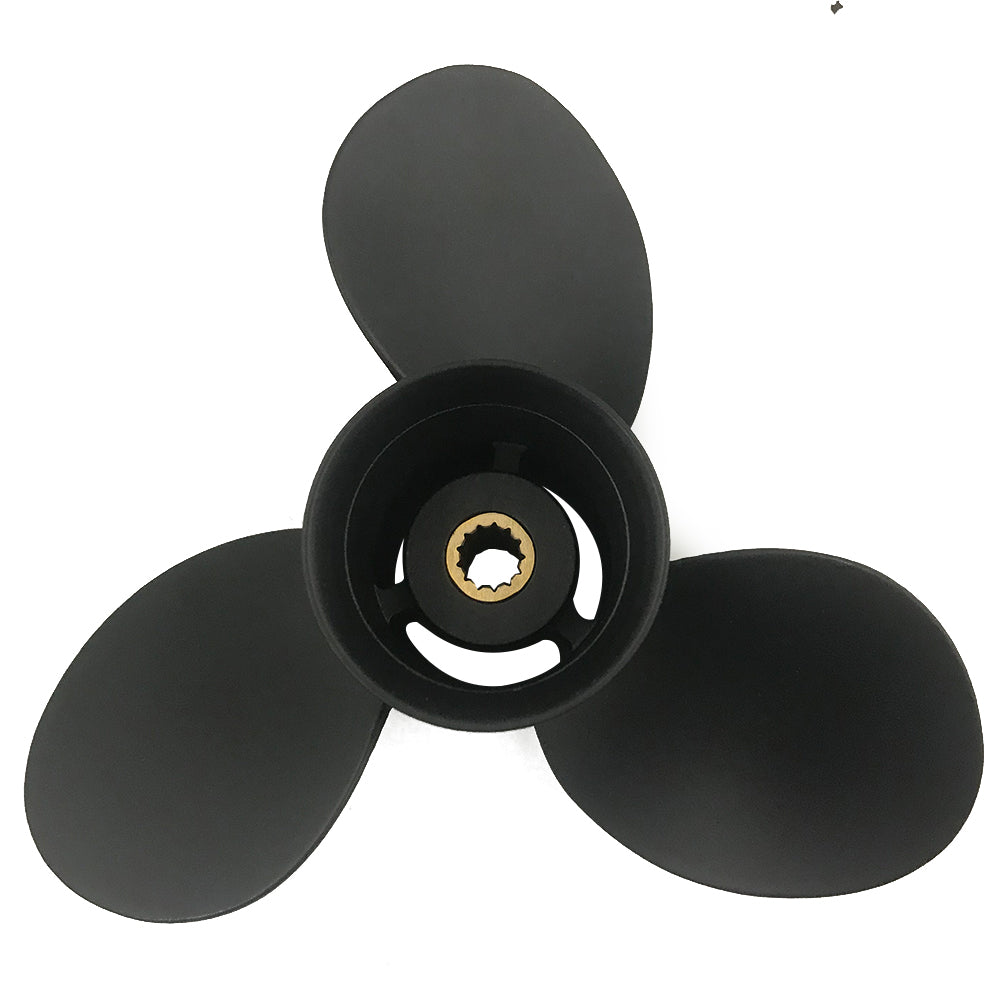Providing insight into the latest propeller maintenance techniques will help restore or upgrade your Yamaha outboard propeller, ensuring optimal performance, reduced fuel consumption, and extending the engine's lifespan. Whether you are an experienced boater or a novice, a little knowledge about basic propeller care goes a long way in affecting the overall operation of the vessel. The article will provide you with expert tips and insights on properly maintaining your existing propeller and assessing when and how to improve it. From enhancements for outboard performance to an improved and fun-filled boating experience, this comprehensive guide will cover Yamaha propellers. So, stay with us as we present information to keep your engine sound and your journey unforgettable.
Understanding Yamaha Outboard Propellers

What is a Yamaha Outboard Propeller?
A Yamaha outboard propeller is a crucial component of a Yamaha outboard motor, specifically designed to convert the engine's power into thrust, propelling the boat forward. These propellers are forged to exact specifications to realize the best in performance, fuel economy, and an incredibly smooth boating experience. They are made of a variety of materials, ranging from aluminum to stainless steel, and come in multiple designs, sizes, and pitches that fit various boats, depending on their purpose and performance. Each propeller is also designed to fit specific engine models, ensuring compatibility and greater efficiency.
In Yamaha outboard propellers, emphasis on hydrodynamics and durability is one of those features that define the product. The pitch of a propeller—the distance that a propeller traverses in one revolution of a boat- needs special consideration because if it is properly matched with the kind of RPM an engine has, it would provide an extra advantage to the extent of the performance. Yamaha takes pride in offering—the option could be either 3-blade or 4-blade configuration-some customizations that boaters may wish to make in selecting speed, acceleration, or carrying capacity. Stainless steel propellers appeal to those concerned with performance, as they are exceptionally corrosion-resistant. In contrast, aluminum propellers are lightweight and less expensive for the average boater.
Advanced technologies have been used in Yamaha propeller designs. The Shift Dampener System (SDS) eliminates vibrations while minimizing noise, resulting in nearly silent shifts that are beneficial for fishing or recreational use. Similarly, the company provides in-depth guidelines and support on selecting the proper propellers, ensuring that all occasions spent on the water are enjoyable and efficient. A tacky finish of innovation and quality; Yamaha propellers ensure professionals enjoy solving problems for the average boater alike with dependable, high-performance solutions.
Types of Yamaha Propellers: Stainless Steel VS Aluminum
When deciding between stainless steel and aluminum Yamaha propellers, it is essential to understand the strengths and applications to which these metals are most suited. Stainless steel propellers are famous for their strength and performance. Being resistant to damage is particularly helpful when navigating high-speed boats or waters with debris that can impede the propeller's operation. A rigid construction enables the blades to be formed more accurately, ensuring optimal propulsion and fuel efficiency. Although often more expensive than aluminum, stainless steel propellers should last practically an eternity, making them undoubtedly worth the investment for any regular or fairly demanding user.
Aluminum propellers, on the other hand, offer a more economical option, often favored for recreational and casual boating. Since they are lightweight and easy to repair, they are classified as more of a general-use product. Compared to stainless steel propellers, aluminum propellers may lack a level of strength, but they can perform competently under regular working conditions and are available in various sizes and designs. For several boat owners, aluminum propellers are the option that best balances cost and function.
Ultimately, the choice of type depends primarily on the customer's boating needs, working conditions, and budget. Yamaha equips their arsenal with options in both metals, each crafted to perfection to suit various requirements, so that regardless of the material chosen, you will have the best-looking and well-performing prop.
The Importance of Choosing the Right Outboard Propeller
Selecting the correct outboard propeller is the most crucial choice for achieving maximum performance, efficiency, and service life from the boat. A properly selected propeller, for instance, aids in optimizing fuel consumption, generating thrust, and facilitating the boat's easy handling in changing water conditions. Thus, pitch and diameter influence speed and engine RPM, while improper dimensions can lead to poor performance or, worse, engine damage.
With the advances made in propeller design, state-of-the-art materials, and excellent geometrical working methods, the set of requirements of today's boating farmer is fulfilled. This high-performance selection is tailored to the specific needs of speedboats, fishing boats, and recreational watercraft, with designs optimized for carrying capacity and water drag to achieve efficient propulsion.
A propeller investment, in other words, contributes to long-term cost savings. A particular prop achieves this by reducing engine strain, thereby extending engine life and lowering associated maintenance costs. Under normal conditions, specific quantitative metrics, such as try speed, acceleration time, and cavitation reduction, may be considered to provide evidence of the benefits obtained by using the right propeller.
Finally, taking into account opportunities created by your boat's size, weight, and very custom use pattern, you can make an informed decision. To ensure coherence with your personal needs, examine adaptations that will serve your vessel well and enrich the fond memories of your water adventures.
Maintenance Tips for Yamaha Propellers

Regular Inspection and Cleaning
Regular maintenance of your Yamaha propeller begins with inspection and cleaning to ensure it runs smoothly and lasts longer. Performing regular checks will help determine damages, such as nicks, cracks, or corrosion, which may reduce its efficiency and also lead to mechanical troubles affecting its operation. For cleaning, it is essential to ensure that debris, algae, or barnacles gathered on the propeller are removed, especially when returning from saltwater or dark areas. Use a soft-bristled brush alongside the non-abrasive cleaner so as not to scratch the surface of the propeller. Thereafter, apply marine-grade grease to the propeller shaft to prevent rusting and ensure smooth operation.
Also, check for any imbalance in the propeller, wherein there could be chipping or bending, which would cause vibrations leading to damage to the drive train. Such conditions should be addressed immediately; hence, it will also save the propeller and keep your boat in good shape. Through regular maintenance, you can achieve an extended service life for your Yamaha propeller, resulting in numerous smooth and efficient rides.
How to Check for Damage and Wearing-Out
Inspecting the Yamaha propeller to identify damage and wear is crucial for maintaining its usability and avoiding expensive repairs. Inspect the blade edges for nicks, dents, or cracks that are visible to the naked eye. A slight imperfection can bring adverse effects on the balance and performance of the propeller. Make sure the blades are not bent, as bending will cause uneven thrust and put undue stress on engine components. Lastly, also check the propeller hub for corrosion or rubber breakdown, because these will weaken the connection to the drivetrain.
Watch out for unusual vibrations or noises while running, as any of these could indicate deeper issues related to either the propeller or its alignment. For ensuring better analysis, it can be helpful to measure the pitch and diameter of the propeller against those specified by the manufacturer. This ensures that any deviation has not occurred due to wear or damage. And last, but certainly not least, ensure that the securing hardware-a prop nut and cotter pin in this case-is in good shape and is securely tightened. This way, you will have your propulsive unit checked to ensure optimal performance and longevity, and you certainly will not be heading for boring breaks while out in the water.
Proper storage techniques for your propeller
Ensuring proper propeller storage goes a long way in protecting it against damage, corrosion, and unnecessary wear during periods of non-use. First, clean the prop thoroughly with freshwater to remove all salt, dirt, and other foreign objects that could promote corrosion over time. Dry everything thoroughly, as any trapped moisture can cause rust to form. Next, inspect the propeller for damage, cracks, or bent blades; properly fixing these issues before storage ensures the propeller is ready for use at a moment's notice.
For added protection of the propeller, consider applying a light coating of anti-corrosion lubricant to any metallic surfaces. Store it in a dry, temperature-controlled place, as humidity and extreme temperatures can degrade the materials over time. If possible, store the propeller in its case or cover it with a soft cloth to protect it from scratches and dings caused by accidental impacts. Consider labeling the propeller with detailed specifications, such as size, so you can easily identify which boat it belongs to later. And with such storage methods, you will keep the propeller in prime condition, drastically reduce maintenance, and ensure maximum performance every time you finally get on the water.
Upgrading Your Yamaha Propeller

When to Consider Upgrading Your Outboard Propeller
Upgrade your outboard propeller for enhanced boat performance, improved fuel economy, and improved handling. Here are some pivotal situations in which you may want to consider making a change:
Reduced Speed: Your boat cannot reach its maximum top speed, feels slow while accelerating, or struggles to maintain a steady glide - this is essentially an underperforming propeller. A new propeller designed for the ratings of your engine and water conditions can restore the propeller's performance.
Fuel Inefficiency: An ill-matched or defective propeller will cause costly fuel-economic wastage. By upgrading to one with the right pitch and blade design, you will maximize fuel efficiency and save money in the long run.
Changing Boating Needs: Different activities require different props, such as fishing, water sports, and offshore cruising. When upgraded to a professional propeller, the experience improves, and you may also feel that the propeller should now meet your needs.
Material and Design Advancements: Newer propellers are typically made from materials like stainless steel, which resist corrosion better than aluminum and last much longer. The refined designs enable better hydrodynamics, reduced cavitation, and consequently improved performance.
Damage or Wear: Considerable damage, such as a crack, a bend, or a chip, will render your propeller useless. Even in many cases where it still appears to be functional, its efficiency has been compromised due to occasional wear and tear, so replacing it would be the best option to ensure further safety and reliability.
Engine Upgrades: If an outboard motor has been upgraded or if a change in horsepower has been carried out, it will likely require a suitable propeller to realize the engine's full potential. An unsuitable propeller may cause incomplete engine performance or possibly mechanical damage.
With the right propeller upgrade, you'll enjoy smoother rides and lower operational costs while enhancing your overall experience tailored to your needs. It is always a good idea to consult a marine expert or propeller manufacturer to seek recommendations for the best fit for your setup.
Choosing the Right Yamaha Propeller for Your Boat
Selecting a Yamaha propeller for your boat involves weighing a few key factors to optimize your boat's performance. These factors include material, pitch, diameter, and the number of blades. All these affect the acceleration, finish speed, and fuel consumption of your boat.
Material: A propeller is typically made from different materials, such as aluminium or stainless steel. An aluminium propeller is cheap, lightweight, and good for casual boating. On the other hand, stainless steel is suitable for heavy-duty or high-speed applications because it is easier to maintain and performs more effectively.
Pitch: The pitch of the propeller decides how far the boat will travel for each single rotation of the blades. Higher-pitch propellers attract speedboats because the boat covers more distance with each rotation. In contrast, lower-pitch propellers give the advantage in quick acceleration and are ideal for towing or carrying heavy loads.
Diameter: The diameter describes the circle formed by a rotating blade and determines how much water the propeller can push. The greater the diameter, the more thrust and hence suitable for bigger boats, whereas the smaller the diameter, the less thrust and better for lighter or faster boats.
Blade Count: Three or four-bladed propellers are usually found in the marketplace. Three-blade props offer higher speeds and acceleration, as they are efficient and versatile. Four blades can enhance handling and stability, providing smoother rides in rough waters.
One may, therefore, narrow down the eventual options for the best propeller by analyzing these factors about the boat's specifications and usage. Yamaha also manufactures branded propellers tailored for specific engine types and performance objectives, allowing their clients to enjoy an advantageous boating experience.
Advantages of Changing to a Stainless Steel Propeller
The advantages of stainless steel propellers would be numerous, significantly increasing the boat's performance and durability. Mainly, the strongest and longest-lasting propellers are preferred. Therefore, stainless steel propellers become preferable to aluminum ones, given that they are highly resistant to wear, damage, and corrosion, which are often sought after by avid boaters or those who frequently find themselves in harsh or abrasive water.
The next significant advantage would be performance efficiency. Working with stainless steel propellers allows for precise designs that enable the creation of thin blades with refined geometry, resulting in improved fuel economy. Other benefits often include smoother acceleration, higher top speeds, and superior handling at high RPMs or under heavy load conditions.
Finally, stainless steel propellers will retain their shape even under extreme forces, ensuring consistent performance. These propellers flex little to none while in operation, imparting good feedback and stability even in challenging conditions.
Lastly, considering stainless steel propeller investment as a long-term savings. They might initially set you back more; yet their robustness and the benefits of their working capacities make for fewer replacements and repairs, thereby making people prize stainless steel propellers as an excellent upgrade. By selecting a stainless steel propeller that fulfills all the requirements of the engine and boat, one can enhance the name and value of the ship, which the person may own.
Understanding Propeller Spline and Pitch

What Is a Spline and Why Is It Important?
The spline consists of the teeth or grooves that lie on the inside of the hub of a propeller and engage with the grooves of the engine shaft. Assembling the propeller with the engine enables both to function correctly, with the propeller receiving power from the engine to perform its intended function. The spline design should match the one on the engine, as using a propeller whose spline does not match that of the engine will cause slipping, poor performance, and, at times, engine damage.
Variations in spline types are contingent upon the engine manufacturer and model, with some engines bearing more teeth or with a different diameter. Standard spline sizes for common outboards include 13, 15, and 17, each designed for specific applications. Choosing the proper spline for the propeller ensures easy fitting, along with greater durability and reliability. Lubricating the spline during installation helps prevent wear and corrosion, thereby prolonging the life of the propeller and engine. This technical aspect is crucial for maintaining optimal boat operation and achieving superior propulsion efficiency.
How Pitch Affects Performance and Fuel Efficiency
Propeller pitch has always been a central parameter in determining the boat's functioning and fuel efficiency. The pitch of a propeller is defined as the distance the propeller theoretically thrusts forward through the water in one revolution, measured in inches. Low-pitch propellers cover less distance per rotation and produce more thrust, such that heavier boats or those that need better acceleration and towing torque would benefit from this type. Higher-pitch propellers, conversely, cover more distance with each rotation, giving speed at the cost of increased strain on the engine.
Ensuring the propeller pitch is optimized ensures the engine operates within its specified RPM range and impacts fuel consumption. If the propeller pitch is too high, the engine will be overloaded and therefore not run efficiently; it will gradually wear out over time. If the pitch is too low, the engine will be underloaded, running at too high an RPM, consuming more fuel, and ultimately damaging the engine at the end of the long run. Data shows that if a proper propeller pitch is chosen per the type of boating you do, as well as your engine specifications, fuel efficiency can be increased by as much as 10-15%, and enhanced performance would be a fair trade. Balancing speed, thrust, and fuel economy through pitch allows the boat to run more smoothly and operate at a lower cost.
How to Select the Correct Pitch for Your Yamaha Engine
Choosing the propeller pitch for your Yamaha engine will largely depend on understanding pitch and its influence on a vessel's overall performance and fuel efficiency. Pitch is the distance a propeller would travel in one complete revolution if there were no slippage. Whereas higher-pitch propellers would have higher top speeds, though that usually compromises acceleration and strains the engine when running at low speeds, a lower-pitch propeller thrusts more with faster acceleration, making it suitable for pulling heavier loads or maneuvering in rough waters.
Recent insights at the industry level underscore the growing importance of ensuring the propeller pitch is matched to the manufacturer's recommended RPM range for an engine. With Yamaha engines, operating the engine in the peak RPM zone best suited for it while ensuring efficiency also poses a significant risk that the motor will be overloaded with load. Choosing a propeller pitch to suit the operating capacity of the engine translates into hushed cruising, better fuel economy, and longer motor life for boat or land users. Many boat owners thus find value in performing an RPM check during a broad range of operations with different propellers pitched suitably to gather exact data that will help them confidently select the best option.
Questions about Yamaha Outboard Propellers

Common Questions About Yamaha Propellers
One of the questions that frequently arises when discussing Yamaha propellers is how to select the best propeller for optimal performance. From my own experience, choosing a Yamaha propeller essentially depends on understanding the particular needs of your boat in terms of its use conditions. The most important considerations should be the pitch, diameter, and material of the propeller, balancing these attributes with the horsepower of your outboard engine and your usual boating habits, such as fishing, cruising, or watersports. Ideally, the propeller should balance engine RPM within the operating range recommended by the engine manufacturer, as this ensures the engine runs efficiently at all times, preventing unnecessary strain and allowing it to last longer and perform better.
Another question I often receive is about the difference between an aluminum and a stainless steel Yamaha propeller. I recommend aluminum propellers for casual boaters because they are more affordable, lighter in weight, and suitable for most standard requirements. However, for those seeking improved strength and performance, or enhanced resistance to impact damage, stainless steel is the answer. The strength of steel translates to higher efficiency and better handling, especially in adverse water conditions. Regardless of the material you choose, I strongly recommend you follow Yamaha's propeller recommendations to the letter and arrange for sea trials to confirm the best fit for your boat and outboard combination.
How to Identify Genuine Yamaha Propellers
Genuine Yamaha propellers always have official markings and serial numbers. Yamaha was always very particular about the manufacture of its propellers, insofar as they were purchased from an authority certified under Yamaha’s quality control standards. These markings are significant: The companies use the Yamaha logo, the part number, and other requirements pertinent to the propeller. It is essential to always compare these specifications with official Yamaha catalogs or consult a reputable dealer to ensure accuracy.
I also pay significant consideration to the ultimate quality of manufacturing. Genuine Yamaha propellers will have that satin finish, precise dimensional requirements, and confirmatory performance characteristics. Counterfeit or aftermarket propellers often reveal their identity through rough edges, uneven surfaces, or poor alignments. I also insist on good-looking packaging when buying a Yamaha prop. Yamaha-branded products use packaging that is clearly labeled and crisp, with the correct descriptions, thus somewhat lessening the risk of inadvertently purchasing a counterfeit.
The last advice is that it pays to buy from official Yamaha dealers and reputable sellers. Being certified, of course, they would guarantee genuine parts with informed technical support, so you never have to encounter an imitation or counterfeit. If you are still not convinced, you can always check with Yamaha through their website or by calling customer service. Buying the right genuine Yamaha propellers for your boat is quintessential in attaining the best performance, safety, and longevity throughout your boating adventures.
Knowing About Solas Propellers and Their Compatibility
Exceptional quality, durability, and performance make Solas propellers favorites among many boaters. Regarding compatibility, I primarily consider the propeller's engine specifications for my boat and its intended use. Solas offers a wide range of propellers to fit various engine brands and models, which helps ease the selection process. There are options for stainless steel or aluminum. The former is more expensive and capable of high performance, and the latter is economical with moderate performance. I consider reviewing Solas compatibility charts or involving customer support to be beneficial in narrowing down the best propeller for my set.
Knowing the pitch, diameter, and material of a propeller is vital for me when choosing one for my boating needs. For instance, when focusing on speed, I might go for a low-pitched propeller, while high-pitched ones are better suited for efficiency. Solas offers detailed specifications that I can cross-reference with the manufacturer's instructions for my boat. Equally valuable are their easy-to-understand resources, including online calculators and manuals, which make finding the right fit easy. After doing proper research, I believe I've chosen a Solas propeller that not only enhances the performance of my boat but also increases its fuel efficiency.
It boils down to selecting your propeller, doing your homework, and aligning it with the specific type of boating activities, whether it's water sports, fishing, or cruising. I have always appreciated Solas' dedication to quality and support, which enables me to make an informed decision that keeps my boat operating smoothly.
Reference Sources
-
Propeller Maintenance Guide
Offers detailed steps and products to maintain Yamaha outboard propellers for peak performance and efficiency. -
Yamaha Outboard Propeller Removal, Inspection, & Maintenance
A step-by-step guide for safely removing, inspecting, and maintaining Yamaha outboard propellers. -
Damaged Boat Prop 101
Discusses how to repair damaged propeller blades and maintain their functionality. -
Upgrade Stainless Steel Outboard Boat Props
Highlights the benefits of upgrading to high-quality stainless steel propellers for Yamaha outboards.
Frequently Asked Questions (FAQs)
Choosing The Right Yamaha Propeller For Your Outboard Motor?
Selecting the Yamaha propeller for your outboard motor depends on the horsepower, type of boat, and intended usage. For example, a three-blade propeller works best with very light ships; on the other hand, four-blade propellers must be installed in heavier boats to ensure better grip and stability. Moreover, depending on the RPM range, the pitch of a propeller may need to change. Yamaha educates customers on choosing a prop by providing an online prop selector, allowing them to find suitable props for their engines and style of boating.
What Are the Advantages of Stainless Steel Yamaha Outboard Propellers?
Stainless steel Yamaha outboard propellers have several advantages over aluminum ones. They are much more durable when operating in a rough environment, providing better performance and a quieter ride. Additionally, the design of stainless-steel props typically features sharper blades, which may enhance fuel efficiency and overall performance of the outboard. They, too, are more sustainable over time, meaning they will pay for themselves in the long run if you are a serious diver with a boat. Aluminium props will be less expensive, though.
How Do You Determine the Correct Pitch for Yamaha Outboard Propellers?
The performance of the boat is greatly affected by the pitch of a Yamaha outboard propeller. A low pitch allows the boat to get up to speed quickly and can thus be helpful for a light craft. It is suited for cruising in shallow waters. A higher pitch is used with large horsepower engines to achieve maximum speed, which might otherwise compromise some acceleration. Testing different pitches would be an advantage in optimizing the performance of the outboard motors, so give it a try.
What is the Importance of Propeller Material for Outboard Performance?
The material of a Yamaha propeller is vital for its working ability and durability. Aluminum propellers are lightweight and cost-effective, making them suitable for most recreational vessel applications. Stainless steel propellers, on the other hand, maintain a better hold in situations of high speed or load. They will not flex as much, allowing the blades to work efficiently and making them the preferred propeller for boats with high-performance outboards. Either way, choosing the right material will promote the performance and longevity of your boat.
How Do I Maintain My Yamaha Outboard Propeller?
Proper maintenance of your Yamaha outboard propeller ensures optimal functioning. An examination is required to determine if the propeller may have been damaged or shows signs of wear, particularly after being submerged in water. Besides cleaning any debris or marine growth off the propeller to maintain efficiency, look for dings or nicks on the hub and blades that might compromise its performance. Another option is to apply an anti-fouling paint layer to protect against corrosion, allowing it to remain in good working condition.
Features of Solas Propellers for a Yamaha Outboard?
Solas props can be mounted on Yamaha outboards, provided they fit the particular make, model, and horsepower requirements of the outboard. These aftermarket propellers are designed to provide a performance edge and therefore share many of the advantages attributed to genuine Yamaha propellers. You must verify the specifications and ensure the propeller meets the requirements of your outboard motor. Choosing the right one for your vessel, SOLAS can give the best performance and value.
